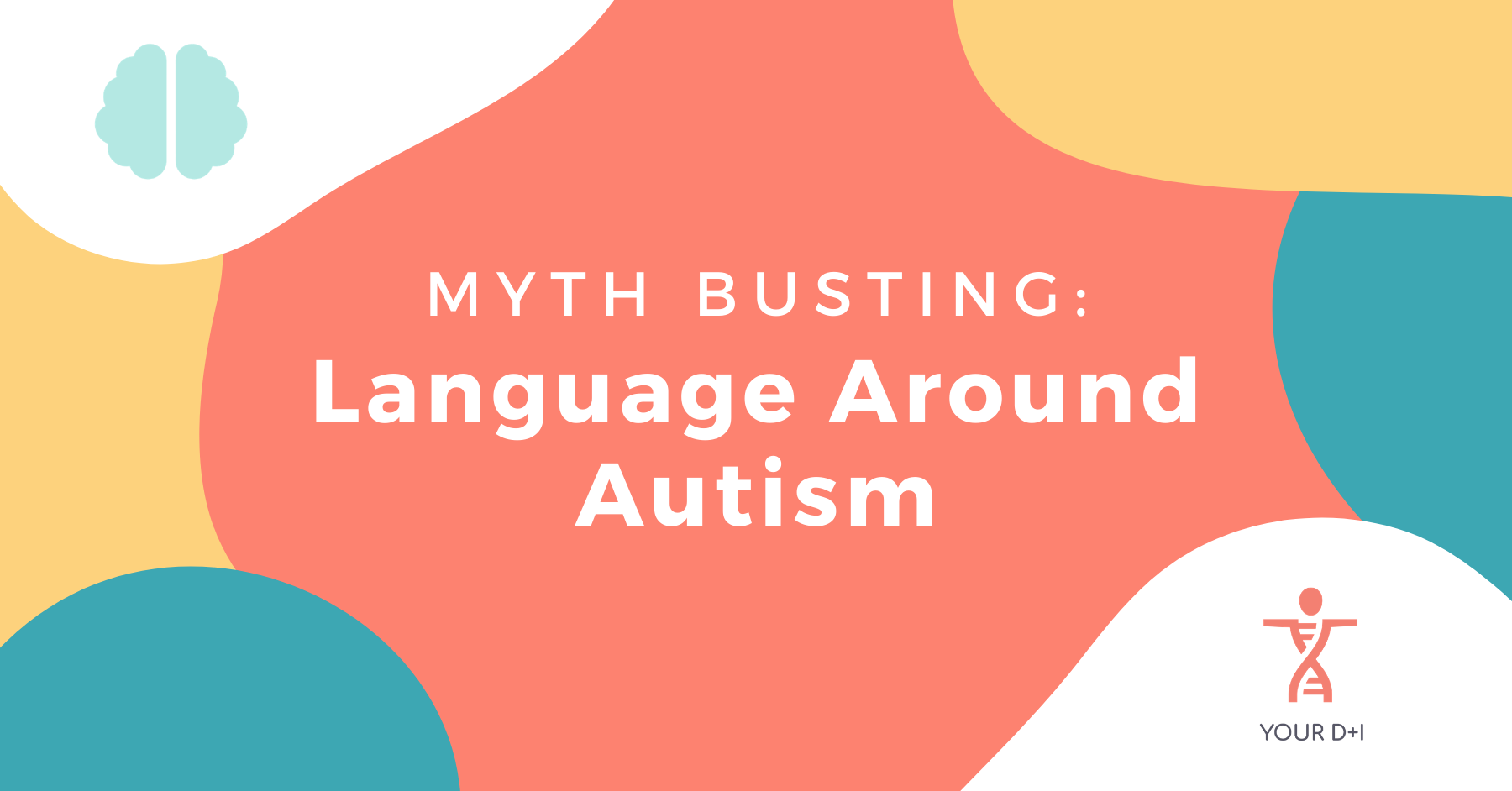Myth Busting: Language Around Autism
Our Myth Busting: LGBT+ blog series has become a well-loved regular on the Your D+I blog. However, we’re mixing things up a little and extending the series into other topics. After all, there are myths to bust in all areas of Diversity + Inclusion. So, beginning with this post on language around autism, we’re starting a new series called Myth Busting: Neurodivergence.
If you’re a fan of the LGBT+ version of this series, don’t worry. We’ll still be busting LGBT+ myths every now and then! Today, however, we will be talking all about the language around autism, also known medically as Autism Spectrum Disorder. So get ready to learn the truth behind some harmful misconceptions about autistic language. First, though, let’s begin with a quick definition.
What is autism?
Autism is a neurodevelopmental disability that affects how a person interacts with and perceives the world. For example, an autistic person might experience difficulties with social interaction, sensory processing and managing emotions. Autistic people often also have deep interests in certain subjects, known as special interests, and an affinity for routine.
However, autism is a spectrum, and all autistic people have different traits and experience these traits uniquely. There is no simple definition of what it is to be autistic because there is no one way (or even two ways as some would believe) to be autistic.
The cause of autism is unknown, though many believe there are genetic elements. There are many myths about the cause of autism alone, but today’s post covers misconceptions about language around autism, beginning with one of the most common autism myths of all.
‘Autistic people are either high- or low-functioning’
High- and low-functioning terminology was once prevalent in healthcare, which is likely why this myth is both common and persistent. The high-functioning label refers to the idea of ‘mild’ autism. Those labelled as low-functioning are considered to have ‘severe’ autism. However, the autistic community deems functioning labels inaccurate and harmful, and their use in healthcare is also decreasing.
There are many traits that different autistic people can experience and experience to different degrees. This is why the concept of severity is inaccurate. Those deemed high-functioning because they communicate verbally and have fewer meltdowns can be strongly affected by other traits. For example, they may struggle with their memory and regulating their emotions so often feel angry or depressed.
Similarly, a non-speaking autistic person may be labelled as low-functioning even if their other traits aren’t prominent. A person’s experience with autism isn’t about how ‘severe’ it is or how highly they ‘function’ – more useful is understanding what support they need.
Speaking of support, this myth can also prevent autistic people from accessing the support they require. As we’ve established, these labels create confusion by putting people into inaccurate boxes. And these boxes are often used to decide whether somebody deserves or needs support. This can prevent some autistic people from getting the care they need and lead to others receiving the wrong kind of ‘help’.
Functioning labels are also one of the reasons that autistic people are often not listened to. And this is the case even when the topic of discussion is autism. Those labelled as high-functioning are often told they cannot talk for all autistic people because they have fewer needs. And those labelled as low-functioning are ignored because they are either non-speaking or not considered ‘able enough’.
‘Asperger’s is separate from ASD’
Another myth originating in outdated medical terminology, the word Asperger’s is still sometimes used to differentiate from other ‘types’ of autism. There are two main reasons that this is now considered incorrect. The first is that, like high-functioning autism, the term Asperger’s is an outdated functioning label.
The word Asperger’s was previously used to diagnose high-functioning autism, causing many of the issues from the last myth. The term Asperger’s separates those with fewer support needs from the rest of autism, creating unnecessary division. This is why many autistic people urge others who still use the term Asperger’s (usually because they were diagnosed when it was still in use) to refrain from using the label.
The second major reason that this term is no longer used is where the word itself comes from. Hans Asperger was a doctor who collaborated with the Nazi party during the Second World War. Asperger labelled the autistic children he considered high-functioning, and those who did not meet his criteria were murdered. Continuing the use of this word reinforces the idea that some autistic people’s lives are less valuable than others. It can also remind autistic people of the murders of people like them.
‘You should use person-first language’
When it comes to disability, and autism in particular, there is a well-known debate over person-first language. Many, including people who work in medicine and care, argue that person-first language should be used to describe autistic individuals.
Person-first language is when you use the word ‘person’ before an identity, autism in this case. For example, calling someone a ‘person with autism’ instead of an ‘autistic person’, which would be identity-first language. Some people believe person-first language is better because it puts being a person before being autistic. However, others argue that you shouldn’t need to use person-first language to remember that autistic people are people.
And, in fact, the vast majority of autistic people use, and prefer when others use, identity-first language. One reason for this is that person-first language makes it sound like autism is not an inherent part of an autistic person and is instead removable. For example, person-first language is often used when someone has a temporary illness, like saying ‘person with conjunctivitis’. Therefore, person-first language can imply that autism is an illness and can be cured, which is a harmful view.
If an autistic person specifically requests that you use person-first language to describe them, go ahead. Otherwise, using identity-first language should be the standard as it is the preference of most autistic people.
Prioritise autistic people
When it comes to language surrounding autism, there are many myths about what is correct and even okay. From the best way to refer to people to outdated categories, using the wrong language can be very harmful.
However, like with any identity, you can (and should) listen to those the identity applies to. Autistic people are the only ones who experience autism, and they know what language they prefer for describing themselves.
If you hear allistic (non-autistic) people perpetuating these myths about autism, don’t be afraid to correct them. By reducing the spread of inaccurate language, you will in turn help reduce the harm it does to the autistic community.


